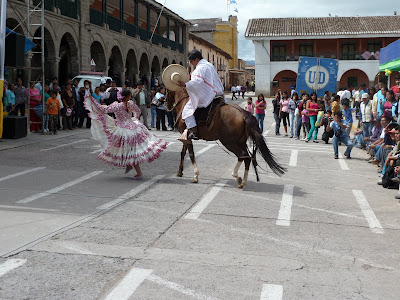


This afternoon we witnessed the Marinera danced by a rider on horseback and a beautifully dressed young Peruvian woman. There was also a second rider and young woman dressed equally impressively. The performance was part of the annual “Tuna and Cochineal” festival held around this time. Remember that both the tuna fruit and cochineal come from the same cactus plant which grows prolifically around Ayacucho.
The performance was spectacular, the dancer and horse moved in perfect unison with the music as they circled each other in the Plaza.

The history of the Marinera is very interesting; it is a coastal dance of Peru, generally called the “National Dance of Peru.” Marinera is a graceful and romantic couple’s dance that uses handkerchiefs as props. The dance is an elegant and stylised reenactment of a courtship, and it shows the blend of the different cultures of Peru. The dance itself has gained a lot of recognition and is one of the most popular traditional dances of Peru. During the month of January, in the city of Trujillo north of Lima, a National Contest of Marinera is held.
The origin of the Marinera is generally traced back to the Zamacueca, an ancient colonial dance that originated in the Viceroyalty of Peru, taking its roots from African, Spanish and Andean rhythms. Nevertheless, there are various other theories about where it comes from. The traditional accompaniment for the dance is provided by guitars and bugles.
The popularity of the Zamacueca would eventually lead to it flowing out of the main region of Peru to other South American countries. The dance would slowly evolve as it took on new influences; however, the basic steps of the dance remained the same. The Zamacueca is not widely popular yet several dance institutions in Peru dedicate part of their time to teaching it.

No comments:
Post a Comment